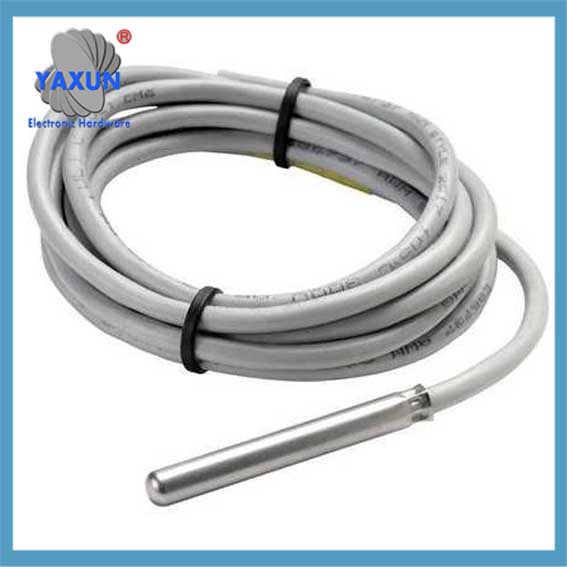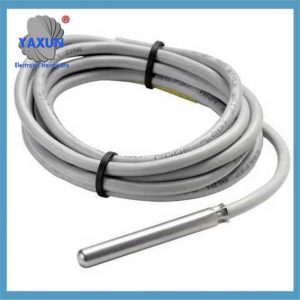Categorie di prodotti
- fusibile termico 32
- fusibili a montaggio superficiale 12
- termistore 36
- Portafusibili per montaggio su PCB 27
- Cablaggio 6
- Portafusibili a lama 17
- termostato 50
- Fusibile elettrico 24
- Sensore di temperatura automobilistico 7
- Interruttore termico 22
- Portafusibili 36
- Sensore di temperatura 75
- Interruttore termico 68
- Fusibile per auto 20
- Fusibili imbullonati 8
Tag dei prodotti
NTC, PTC, PT100, DS18B20 per sensori sonda di temperatura
Sonda termocoppia: Utilizza l'effetto termoelettrico per misurare la temperatura, e ha le caratteristiche di un ampio intervallo di misurazione e di una rapida velocità di risposta.
Sonda di resistenza termica: utilizza la proprietà secondo cui la resistenza dei materiali metallici o semiconduttori cambia con la temperatura per misurare la temperatura, e ha le caratteristiche di elevata precisione di misurazione e buona stabilità.
Sonda a semiconduttore: utilizza la proprietà secondo cui la conduttività dei materiali semiconduttori cambia con la temperatura per misurare la temperatura, e ha le caratteristiche di piccola dimensione, leggero e basso consumo energetico.
NTC, PTC, PT100, Le sonde di temperatura e i sensori di temperatura DS18B20 svolgono un ruolo importante nel campo della misurazione della temperatura. Quella che segue è un'introduzione dettagliata ai sensori della sonda di temperatura:
Esistono molti tipi di sensori di temperatura, compreso:
Termocoppie
Questi sensori sono realizzati da due metalli diversi che si collegano a due punti per formare una giunzione. Sono affidabili, accurato, e può funzionare per una vasta gamma di temperature.
Rilevatori di temperatura di resistenza (RTD)
Questi sensori si basano sulla variazione della resistenza di un metallo man mano che la temperatura cambia.
Termistori
Questi sensori usano le caratteristiche di temperatura dei resistori a semiconduttore, che cambia resistenza man mano che la temperatura cambia. I termistori sono sensibili e hanno un'elevata precisione rispetto al loro costo.
Coefficiente di temperatura negativo (NTC) termistori
Questi sensori sono sensibili e possono rispondere a variazioni di temperatura molto piccole. Hanno un intervallo di temperatura di -50 ° C a 250 °C.
Rilevatori di temperatura resistiva
Questi sensori hanno coefficienti di temperatura positivi (PTC) e offrire misurazioni precise della temperatura. Tuttavia, Hanno una scarsa sensibilità.
1. Definizione e principio di lavoro
Temperatura sonda:
Definizione: Una sonda di temperatura è un dispositivo specificamente utilizzato per misurare la temperatura, e il suo componente centrale è un elemento sensibile alla temperatura.
Principio di lavoro: Una sonda di temperatura utilizza elementi sensibili (come termocoppie, resistenze termiche, semiconduttori, ecc.) Per convertire le variazioni di temperatura in segnali elettrici per l'elaborazione o la visualizzazione del circuito successivo.
Temperatura Sensor:
Definizione: Un sensore di temperatura è un concetto più ampio che include una sonda di temperatura e un circuito di elaborazione del segnale collegato ad esso.
Principio di lavoro: Un sensore di temperatura non include solo un elemento sensibile, ma ha anche un circuito di elaborazione del segnale in grado di completare l'acquisizione, elaborazione ed emissione di segnali di temperatura, di solito sotto forma di segnali digitali o analogici.
2. Tipi e caratteristiche
Temperatura Sonde Type:
Sonda termocoppia: Utilizza l'effetto termoelettrico per misurare la temperatura, e ha le caratteristiche di un ampio intervallo di misurazione e di una rapida velocità di risposta.
Sonda di resistenza termica: utilizza la proprietà secondo cui la resistenza dei materiali metallici o semiconduttori cambia con la temperatura per misurare la temperatura, e ha le caratteristiche di elevata precisione di misurazione e buona stabilità.
Sonda a semiconduttore: utilizza la proprietà secondo cui la conduttività dei materiali semiconduttori cambia con la temperatura per misurare la temperatura, e ha le caratteristiche di piccola dimensione, leggero e basso consumo energetico.
Temperatura Sensore Type:
Sensore di temperatura analogico: Output segnali analogici, che devono essere convertiti in segnali digitali da convertitori da analogico a digitale per la successiva elaborazione.
Sensore di temperatura digitale: emette direttamente i segnali digitali, ha una forte capacità anti-interferenza, alta precisione, ed è facile da integrare nel sistema di controllo.
Sensore di temperatura intelligente: ha l'autodiagnosi, autocalibrazione, comunicazione e altre funzioni, e può realizzare il monitoraggio e il controllo remoto.
3. Selezione e applicazione
Fattori di selezione:
Ambiente di applicazione: Considerare se l'ambiente misurato presenta condizioni speciali come la corrosività, alta temperatura, alta pressione, ecc., in modo da selezionare materiali e livelli di protezione adeguati.
Intervallo di misurazione: Selezionare un sensore adatto in base all'intervallo della temperatura da misurare per garantire che il sensore possa misurare con precisione entro l'intervallo richiesto.
Requisiti di precisione: Secondo i requisiti di accuratezza dell'applicazione per la misurazione della temperatura, Seleziona un sensore con precisione corrispondente.
Budget dei costi: Sotto la premessa di garantire la performance, Considera i fattori di costo e scegli sensori economici.
Aree di applicazione:
Automazione industriale: Utilizzato per monitorare le variazioni di temperatura delle attrezzature industriali, macchine e processi di produzione per garantire il normale funzionamento delle attrezzature e la qualità del prodotto.
Industria medica: Utilizzato nelle attrezzature mediche, Strumenti di monitoraggio della temperatura e apparecchiature di conservazione del farmaco per monitorare la temperatura del paziente, Condizioni di temperatura ambiente e conservazione dei farmaci.
Industria automobilistica: Utilizzato nei motori dei veicoli elettrici, condensatori, Convertitori DC, sistemi di ricarica, così come i motori automobilistici, cambi, Sistemi di condizionamento dell'aria e sistemi di scarico per monitorare e controllare la temperatura di vari liquidi e gas.
Industria dell'agricoltura e della trasformazione alimentare: Utilizzato nelle serre agricole, cure cellm, Attrezzature per la trasformazione degli alimenti e veicoli di trasporto per monitorare e controllare la temperatura dei prodotti agricoli e degli alimenti.
Altri campi: come l'industria del condizionamento dell'aria e della refrigerazione, Industria militare e aerospaziale, Internet of Things Industry, ecc. sono anche ampiamente utilizzati.
IV. Usa e manutenzione
installazione: Installare correttamente il sensore in base alle istruzioni di installazione per garantire un buon contatto tra il sensore e l'oggetto da misurare ed evitare errori di misurazione causati da un'installazione impropria.
cablaggio: Collegare correttamente la linea del segnale e la linea di alimentazione del sensore per garantire la stabilità e l'accuratezza della trasmissione del segnale.
Calibrazione: Calibrare regolarmente il sensore per garantire che la precisione della misurazione soddisfi i requisiti dell'applicazione. Il processo di calibrazione di solito comporta il posizionamento del sensore in un ambiente di temperatura noto, confrontando la differenza tra il suo valore di output e il valore standard, e apportare le modifiche necessarie.
manutenzione: Pulire e manutenere regolarmente il sensore per evitare la polvere, sporco, ecc. che influenzano le prestazioni di misurazione del sensore. Allo stesso tempo, Prestare attenzione per verificare se la connessione via cavo è allentata o danneggiata, e sostituire le parti danneggiate in tempo.
In sintesi, I sensori della sonda di temperatura hanno una vasta gamma di applicazioni e una posizione importante nel campo della misurazione della temperatura. Quando si selezionano e li usi, È necessario fare considerazioni complete in base agli scenari e ai requisiti specifici per garantire l'accuratezza e l'affidabilità dei risultati della misurazione. Se hai altre domande o hai bisogno di ulteriore aiuto, Per favore, non esitate a farmelo sapere.
Contattaci
Aspetto la tua email, ti risponderemo entro 12 ore con le preziose informazioni di cui avevi bisogno.
 English
English Afrikaans
Afrikaans العربية
العربية বাংলা
বাংলা bosanski jezik
bosanski jezik Български
Български Català
Català 粤语
粤语 中文(简体)
中文(简体) 中文(漢字)
中文(漢字) Hrvatski
Hrvatski Čeština
Čeština Nederlands
Nederlands Eesti keel
Eesti keel Suomi
Suomi Français
Français Deutsch
Deutsch Ελληνικά
Ελληνικά हिन्दी; हिंदी
हिन्दी; हिंदी Magyar
Magyar Bahasa Indonesia
Bahasa Indonesia Italiano
Italiano 日本語
日本語 한국어
한국어 Latviešu valoda
Latviešu valoda Lietuvių kalba
Lietuvių kalba македонски јазик
македонски јазик Bahasa Melayu
Bahasa Melayu Norsk
Norsk پارسی
پارسی Polski
Polski Português
Português Română
Română Русский
Русский Cрпски језик
Cрпски језик Slovenčina
Slovenčina Slovenščina
Slovenščina Español
Español Svenska
Svenska ภาษาไทย
ภาษาไทย Türkçe
Türkçe Українська
Українська اردو
اردو Tiếng Việt
Tiếng Việt













